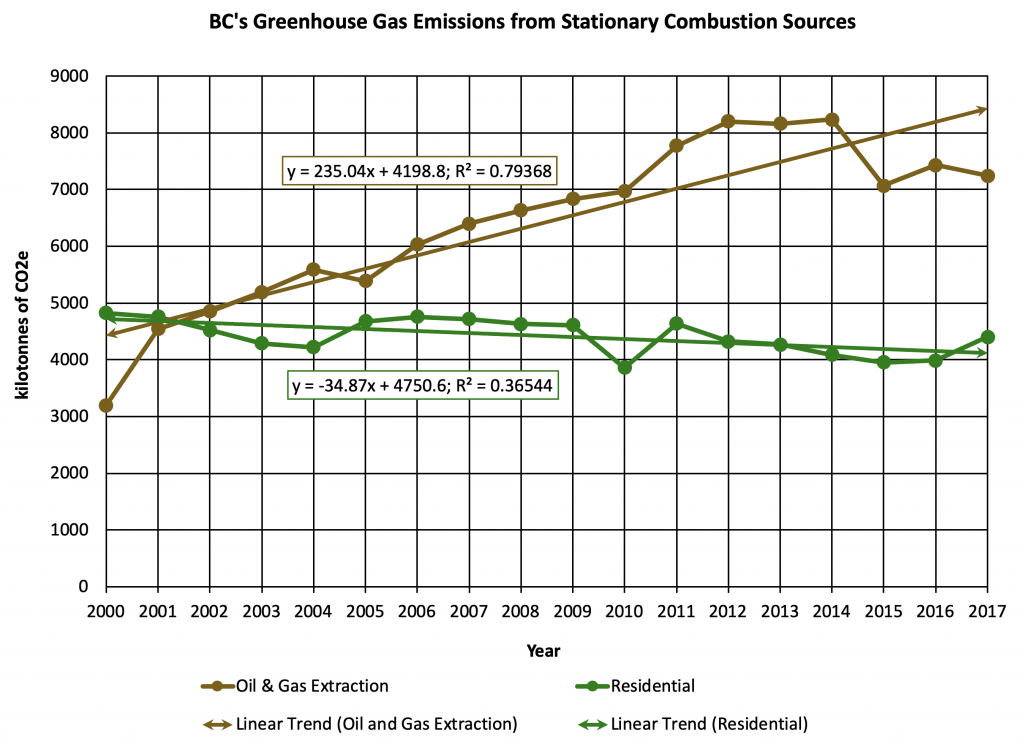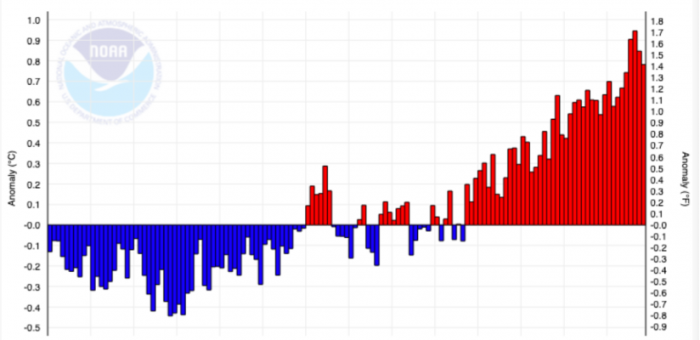BC’s greenhouse gas emissions continue to climb in 2017
The BC NDP government released the 2017 greenhouse gas emissions data today. To no one’s surprise, BC’s 2017 GHG emissions increased by 1.2% from 2016 to 2017 to a total 64.5 million tonnes (Mt) of carbon dioxide-equivalent (CO2e), or roughly 13.1t CO2e per capita. Leading the way was a year-over-year 29% increase in emissions from natural gas flaring. Of course, this too is unsurprising as there is a glut of natural gas in the market and the predominant value from the drilling activity in the northeastern BC’s Montney Formation is in the liquids. A significant fraction of these liquids are shipped to Alberta where they are mixed with bitumen to form dilbit, the less viscous substance that can flow through pipelines. The gas, for which there is no market (and for which we have slashed royalty payments to the province and so literally give away), can be pumped back underground or burnt on site (flaring). And all of these activities are subsidized by the BC taxpayer to the tune of billions of dollars.

As I’ve outlined numerous times over the years on this blog site, with BC’s expansion into LNG, I do not believe the BC NDP government will be able to deliver a plan that will cut GHG emissions to 40% below 2007 levels by 2030. The premier claims that he will. I remain unconvinced.
Nevertheless, I remain very supportive of the CleanBC economic plan, which the BC Greens played an integral role in developing. However, I fear that it may be all for naught. As you will see in the above graph, the trend in emissions from the natural gas sector is on the rise, even without a single LNG facility in place. The trend in emissions from residential buildings is on the decline as we would hope.
Do we believe that it is fair for British Columbians to be burdened with the requirements and cost of reducing GHG emissions while we continue to offer subsidies and corporate welfare to the oil and gas sector? I think not for we have to work even harder as individuals to curb our emissions to account for the continued growth of emissions in the oil and gas sector.
Below I reproduce the media statement that I issued in response to government’s release of these new greenhouse gas emissions data.
Media Release
BC’s greenhouse gas emissions continue to climb
For immediate release
September 9, 2019
VICTORIA, B.C. – At a time when citizens are calling on their governments to ambitiously decarbonize – and every international panel has stated doing so is the only way to meet our agreed upon international climate targets- the provincial government’s recently released greenhouse gas data shows that BC, as of 2017, has failed to correct its emissions trajectory.
The data released today show total emissions in British Columbia increased 1.2 per cent from 2016 to 2017 to a total 64.5 million tonnes (Mt) of carbon dioxide-equivalent (CO2e), roughly 13.1t CO2e per capita. Emissions are now back up to 2007 levels when 64.8 Mt of CO2e was emitted, despite the BC NDP government last year committing to reduce emissions by 40% from this amount by the year 2030.
“We designed the CleanBC economic plan to start to tackle this challenge. Now that it is being implemented I expect we’ll start to see some slight emissions reductions, but it is clear we have a long way to go and we need to remain diligent in our commitment to our reduction targets,” said Dr. Andrew Weaver, leader of the B.C. Greens. “The timing of the release of these new emissions numbers is also particularly ironic as it comes on the heels of British Columbia announcing it’s sending a delegation to Japan to tout the potential export of highly subsidized LNG. As I’ve identified numerous times in the past, we cannot expand investment in the fossil fuel sector and hope to reduce our domestic emissions to promised levels.”
“British Columbians say they want to fight climate change. Looking at this data, they should be enraged that the lack of regulations in the oil and gas sectors means their footprint is two to three times larger than that of the average person living in the UK, Norway, New Zealand, Denmark and Sweden. The average British Columbia emits about 29 times the CO2e compared to an average citizen in Bangladesh.
“Our individual carbon footprint per British Columbian barely come in under our neighbours to the south, by a measly 12%. These numbers show us that we are not the concerned environmental stewards that we think we are, and it is because we have had governments that fail to regulate industry and fail to implement a vision for a new, green economy rooted in sustainable practices.”
This summer, government released its strategic climate risk assessment for British Columbia . Analyzing the climate risks likely to face British Columbia between 2040 and 2059, the report stated:
“British Columbia is already experiencing the effects of global climate change: average temperatures are increasing, sea levels are rising, and variable and extreme weather is becoming more frequent. Scientists expect these changes to accelerate and intensify in the years ahead, creating risks to society, natural resources, and ecosystems.”
British Columbia is contributing to global emissions rising when they need to be falling dramatically. The UN Intergovernmental Panel on Climate Change (IPCC) has repeatedly reported that carbon pollution needs to be cut by 45 percent by 2030 if we are to stay below 1.5C warming, beyond which even half a degree will significantly worsen climate change impacts and drag hundreds of millions of people into poverty.
“Now is not the time to protect the status quo or invest billions in expanding the oil and gas sector,” Weaver said. “Now is the time to rise to the challenge before us. Climate change is an immense risk if we don’t do anything about it. But it is also an incredible opportunity if we act. We can- and must- build cleaner and healthier communities and vibrant, resilient, sustainable economies.”
CleanBC was developed in collaboration with the BC NDP government and supports the commitment in the Confidence and Supply Agreement to implement climate action to meet B.C.’s emission targets.
Quick Facts
In 2016, the most recent global data available from the International Energy Agency, the United Kingdom’s per capita emissions were 5.65t CO2e, New Zealand’s were 6.45t CO2e, Norway’s were 6.78t CO2e, Denmark’s were 5.84t CO2e and Sweden’s were 3.83t CO2e. For comparison, per capita emissions in Bangladesh were 0.45t CO2e and in the United States were 14.95t CO2e.
This puts the average British Columbian’s carbon footprint 2.3, 2.0,1.9, 2.2 and 3.4 times larger than that of the average person living in the UK, Norway, New Zealand, Denmark and Sweden, respectively.
-30-
Media contact
Macon L.C. McGinley, Press Secretary
B.C. Green Caucus
+1 250-882-6187 |macon.mcginley@leg.bc.ca
Comments are closed.



